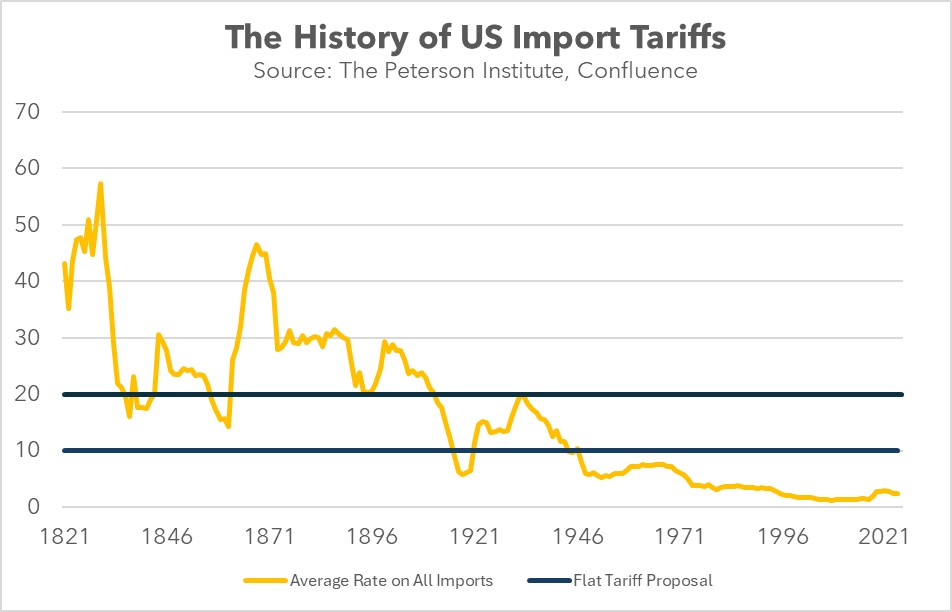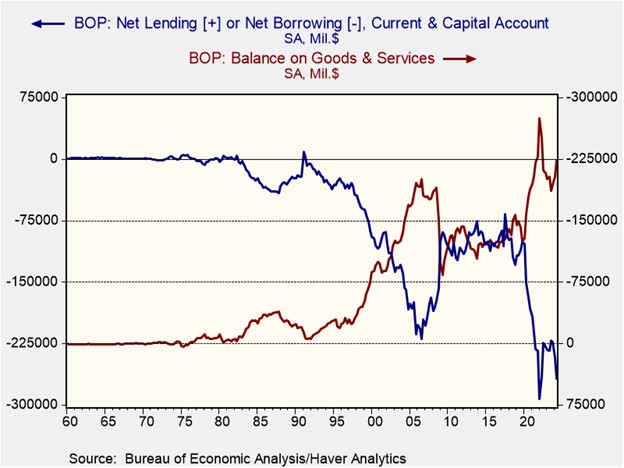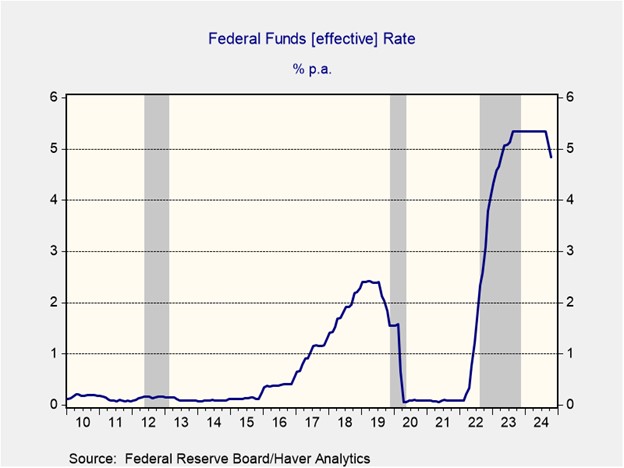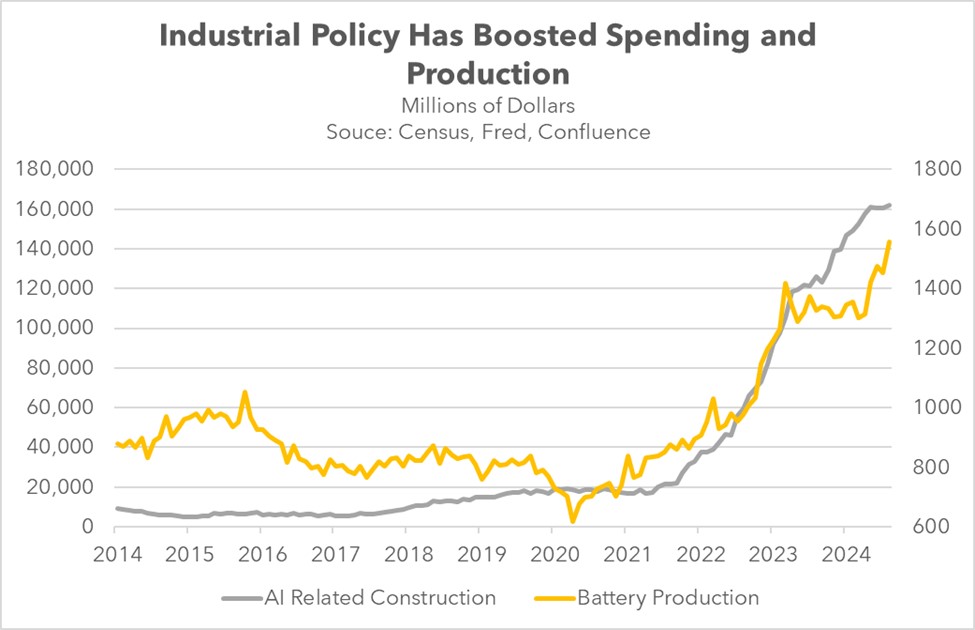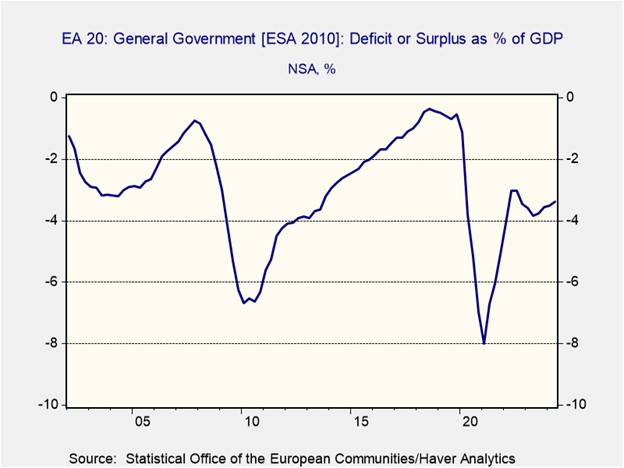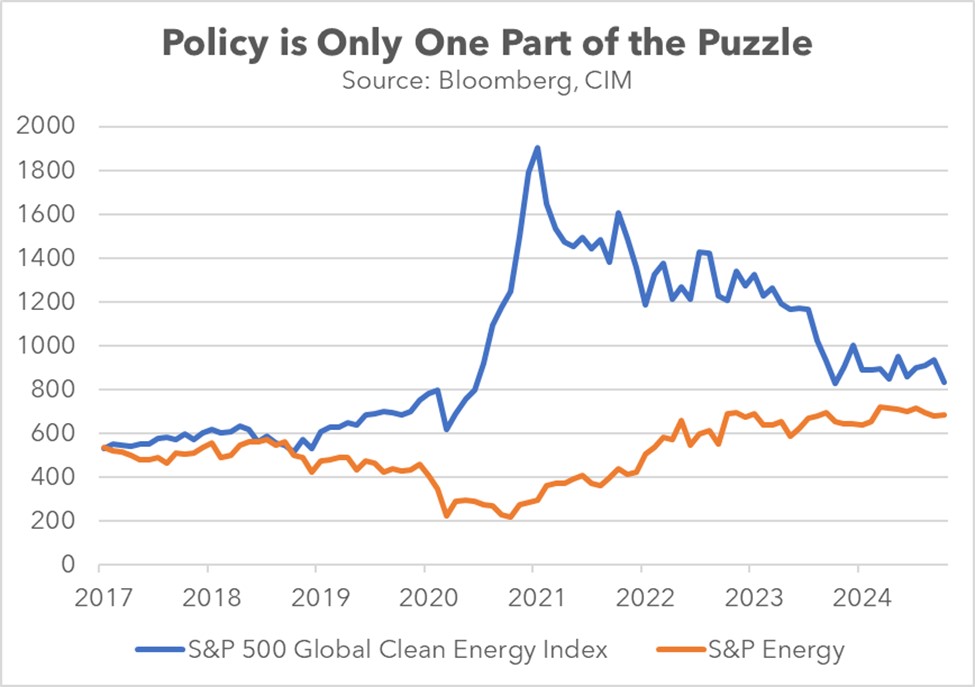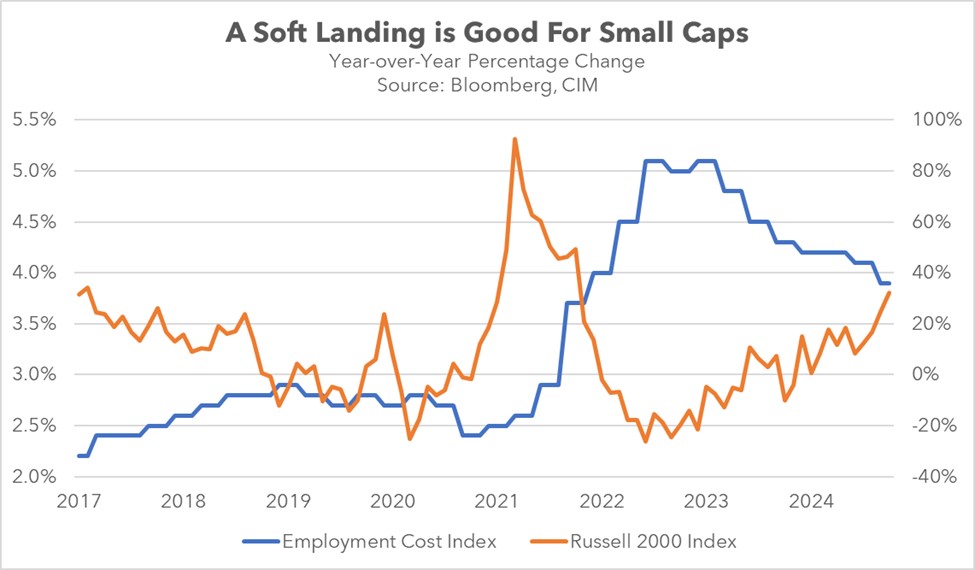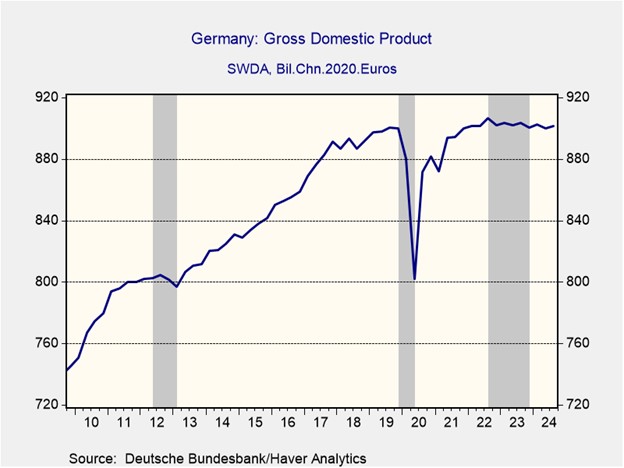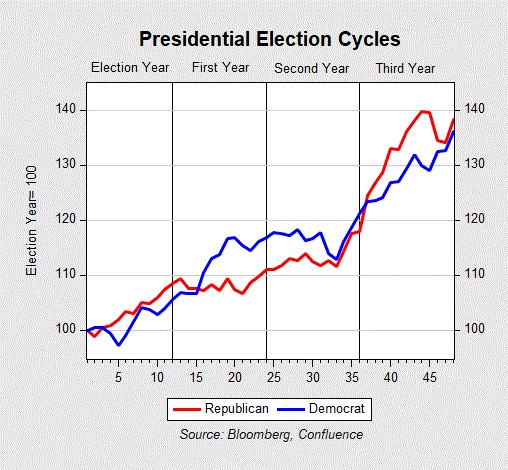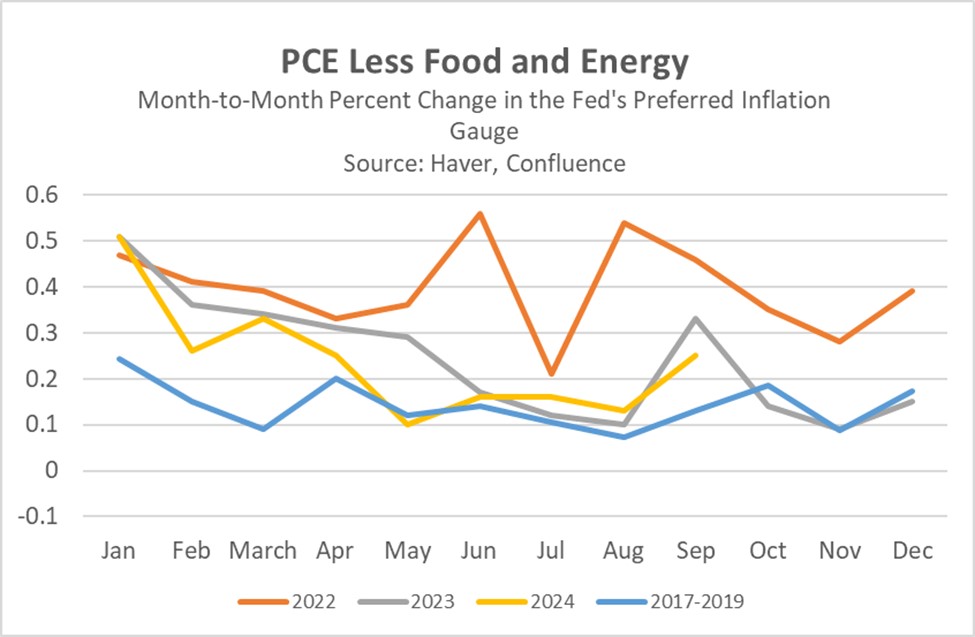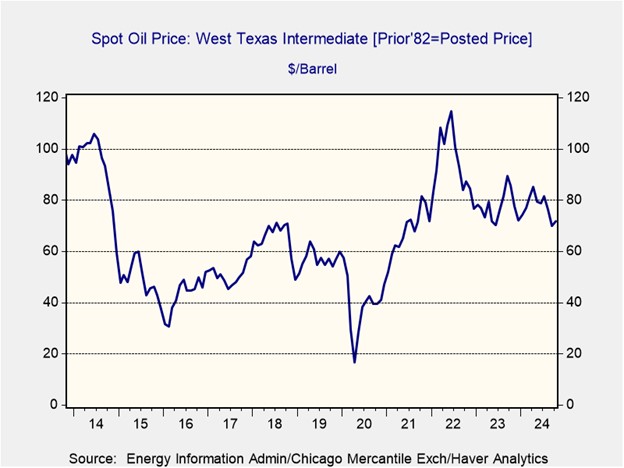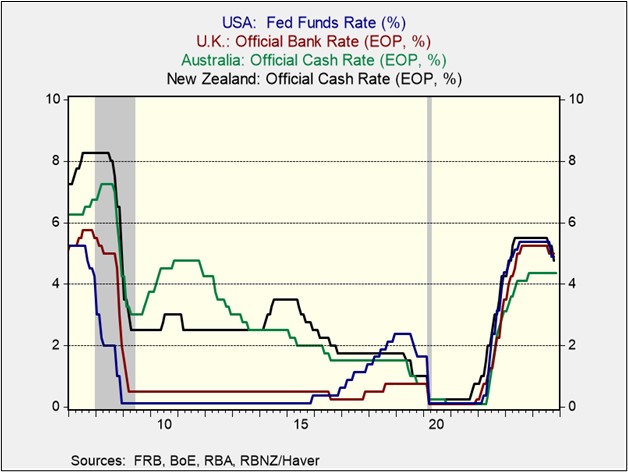Author: Amanda Ahne
Asset Allocation Bi-Weekly – Let’s Talk About Tariffs! (November 11, 2024)
by the Asset Allocation Committee | PDF
In recent years, tariffs have made a surprising comeback. Once widely condemned as a relic of the protectionist past, tariffs reemerged in 2016 as a policy tool against China and are now being considered for implementation on goods from all other countries. Populists tend to believe that these tariffs can be used to address a range of domestic economic issues, including persistent trade and fiscal deficits. They also generally believe that by leveling the playing field for domestic industries, tariffs can ultimately boost living standards for American households.
Under the new proposal, the US would impose a blanket tariff of 10% to 20% on all imports, with additional tariffs of 60% to 100% on goods from China. This would significantly increase the US’s average tariff rate to its highest level in nearly eight decades. The primary goal would be to protect US manufacturers and incentivize foreign companies to shift factory operations to the US, thereby creating domestic jobs. Furthermore, proponents believe that the increased tariff revenue could help reduce the US federal budget deficit. This proposed strategy has resonated with a substantial portion of the American electorate.
Despite its popularity with certain segments of the population, the proposal has faced significant opposition as it contradicts conventional economic wisdom. A tariff is a tax imposed on imported goods. Typically, it is levied as an ad valorem tax, which means it is calculated as a percentage of a good’s value. For instance, if the tariff rate were 10%, then importing a car valued at $10,000 would require paying a tariff of $1,000.
The potential increase in import costs has raised concerns about the proposal’s impact on price inflation. While businesses initially bear the cost of import tariffs, they can often pass a significant portion of this cost onto consumers in the form of higher prices. This economic phenomenon, known as tariff pass-through, is particularly prevalent for goods where businesses have significant pricing power. However, the extent to which tariffs can contribute to inflation and impact the overall economy varies.
When US consumers and businesses purchase foreign goods by paying in dollars, the foreign seller typically will exchange the greenbacks received for their own currency in the foreign exchange market. Therefore, increased US demand for foreign goods should lead to increased demand for foreign currencies, which in turn could weaken the US dollar. However, foreign countries often recycle their dollar holdings back into the US economy, in which case the foreign inflow can paradoxically buoy the dollar and widen the US trade deficit, or at least limit the dollar depreciation and the narrowing of the deficit.
For a flat tariff to successfully reduce trade and fiscal deficits without exacerbating inflation, the US would need to transition from a consumption-driven economy to an export-oriented one. US consumers would need to scale back their demand for tariff-laden imports and/or US producers would need to increase their exports. This shift would require the US to reduce its reliance on borrowing and become a net lender to the global economy. By increasing exports, the US could offset the negative impacts of tariffs and strengthen its economic position. Countries, like China, have achieved this transformation by implementing policies that encourage saving and discourage consumption, often at the expense of social safety nets.
The US dollar’s dominance as the global reserve currency could hinder an export-led growth strategy. Historically, large US trade deficits have supported the dollar’s role as other countries have relied on it for international transactions. To shift this dynamic, the US might need to diminish the dollar’s appeal. This could involve implementing capital controls, as many developing countries do, in order to restrict cross-border capital flows. Alternatively, the US could sacrifice monetary policy autonomy, either by pegging the dollar to another currency or by joining a currency union with other nations.
Because we don’t expect the US to make all the necessary adjustments to become more export-oriented, we believe that potential tariffs could induce foreign countries to devalue their currencies to offset the impact of the tax levy. Accommodative monetary policy could make this possible. This scenario would benefit US companies with limited foreign revenue, such as small and mid-cap companies, as their revenues would likely remain unaffected by currency depreciation. However, this could negatively impact US exporters that rely on foreign sales as the price of their goods could become less competitive.
Daily Comment (November 8, 2024)
by Patrick Fearon-Hernandez, CFA, and Thomas Wash
[Posted: 9:30 AM ET] | PDF
Good morning! Today, the market is closely watching to see if the Republicans can gain enough seats to take control of the House of Representatives. In sports news, the Baltimore Ravens made a remarkable comeback to defeat the Cincinnati Bengals. Today’s Comment will cover the latest FOMC meeting, Trump’s plans to refocus industrial policy, and the adjustments that the EU intends to make for a Trump presidency. As always, our report will also include a roundup of both international and domestic data releases.
Policy Path Uncertainty: The FOMC decided to lower its policy rate as expected but was very vague about the path of future cuts.
- The Federal Reserve lowered its benchmark interest rate by 25 basis points on Thursday, setting the target range at 4.50%-4.75%. This decision was influenced by recent economic indicators, including October’s inflation and employment data, which suggested a potential slowdown in economic activity. While Fed officials acknowledged the possibility of near-term inflationary pressures, they expressed optimism about a potential decline in January. However, they cautioned that uncertainty surrounding certain economic policy changes has complicated efforts to project cuts going into next year.
- The central bank’s reluctance to provide a clear interest rate path suggests a cautious stance, likely shaped by the recent election’s policy implications. In particular, concerns persist that the president-elect’s proposed tax cuts might intensify inflationary pressures. While Fed Chair Jerome Powell avoided directly commenting on fiscal policy proposals, he did describe the current deficit as being unsustainable. He further emphasized the central bank’s commitment to data-driven decision-making, stating that it “does not guess, does not speculate, and does not assume” about future policy shifts.
- Next month’s FOMC meeting will offer markets key insights into the Fed officials’ views on the inflationary impact of potential Trump administration policies. A more hawkish shift could set the Fed on a collision course with the incoming administration. Although there is speculation that Trump might seek to replace Fed officials with loyalists, such a move could backfire by sparking a sell-off in long-term bonds, which could drive up borrowing costs for the consumers he aims to support. A compromise is more probable, with Trump potentially making spending concessions in exchange for lower policy rates.
What’s Next for Build Back Better? Trump’s ascension into the White House will likely refocus but not fundamentally change the direction of policy.
- The president-elect is expected to shift US priorities from using stimulus to incentivize foreign investment in the US to relying on tariffs as the primary tool. Last month, Trump criticized the Biden administration’s spending on stimulus and tax incentives to attract foreign businesses, calling it too costly and suggesting tariffs as a more effective alternative. He has also pledged to cut much of the unspent funding for climate initiatives in the Inflation Reduction Act, aiming to reduce the deficit and refocus the country by expanding fossil fuel production.
- Despite his lack of interest in the two spending bills passed by the Biden administration, Trump is unlikely to reverse most of these changes. The domestic industrialization strategy has driven a sharp increase in spending, fueling a surge in the construction of chip facilities, data centers, and battery production sites. Additionally, the bill was designed to create jobs in key Republican strongholds, making it even more complex to dismantle these initiatives, which may explain why House Speaker Mike Johnson walked back plans to repeal the CHIPS act.
- We expect the next administration to let market forces shape the direction of clean energy initiatives, while largely leaving chip production efforts intact for now. The reluctance to aggressively reverse these policies stems from the Republican party’s need to prioritize its anticipated tax proposals, which will likely face significant scrutiny due to their budgetary impact. Following this, Republicans will also focus on advancing a tariff bill which should also meet some pushback. While some adjustments to the CHIPS and Inflation Reduction bills may occur, we do not expect these to be top priorities.
EU Faces Reality: European unity is poised to be severely tested as the US pursues a strategic realignment that could upend the longstanding relationship.
- European leaders are strategizing on how to approach President-elect Donald Trump while preserving unity within their coalitions. During his campaign, Trump pledged to scale back US support for NATO members that fall short of defense spending targets, pushed for a swift resolution to the Ukraine conflict, and threatened tariffs on all European goods. Although these threats are not new — Trump raised similar issues in his first term — the urgency to address these vulnerabilities has intensified, as they pose a further risk to the bloc’s growth prospects.
- A core challenge for the EU is reducing its dependence on the US for security and trade. Former ECB President Mario Draghi has proposed establishing a unified approach, which he estimates would require a public fund of 800 billion EUR ($861 billion) in additional annual investments. Meanwhile, French President Emmanuel Macron is advocating for the bloc to assert its sovereignty by boosting investment in its domestic defense industry, with a special focus on advancing technologies in artificial intelligence, quantum computing, space, biotechnology, and renewable energy.
- The EU’s ability to counterbalance a more assertive US will depend on its capacity for unity. By overcoming internal divisions and fostering deeper cooperation — potentially through a fiscal union — the EU could improve its access to capital markets through collective borrowing. This will not be an easy process, especially with individual countries struggling to meet deficit targets following the pandemic, but it is likely something the bloc will explore in the coming years. One potential approach could be the issuance of another joint EU bond to fund special projects.
In Other News: Israel is preparing to deepen its war efforts in Lebanon and Gaza in another sign that the conflict is unlikely to end until next year. The Trump team is considering ways to scale back some of the tax promises made during the campaign to facilitate the passage of legislation. Meanwhile, China approved a $1.4 trillion spending program on Thursday, which aims to help bail out local governments. However, there are concerns that this amount of spending may still be insufficient to effectively revive the economy.
Daily Comment (November 7, 2024)
by Patrick Fearon-Hernandez, CFA, and Thomas Wash
[Posted: 9:30 AM ET] | PDF
Good morning! The market is refocusing its attention on the Fed’s rate decision later today. In sports news, the Golden State Warriors defeated the Boston Celtics. Today’s Comment will discuss why investors should not be overly focused on policy agenda. We will also take a deep dive into why small cap stocks have been outperforming the overall market and explore the possibility of snap elections in Germany. As usual, the report will conclude with a roundup of international and domestic data releases.
Red Wave: The S&P 500 had its best post-election rise in history as investors prepare for a Republican takeover of the executive and legislative branches of government.
- Republicans are projected to secure 53 Senate seats and possibly exceed the 218-seat threshold needed to control the House. This anticipated shift has caught investors’ attention, as control over both chambers of Congress means that lawmakers will face fewer obstacles in pushing through pro-growth measures such as tax cuts and the removal of regulations. Financials and Energy outperformed, as both sectors are expected to be big winners. Additionally, there is increasing optimism that AI will face less oversight, potentially boosting research and development in the tech space.
- While policy agendas can be influential, they don’t always drive market returns. As JP Morgan Global Market Strategist Meera Pandit highlights, during Trump’s first term, the S&P Global Clean Energy Index outperformed the S&P Energy Index, rising 275% compared to -40%, respectively. Conversely, under Biden, the overall energy index outperformed clean energy, returning 211% versus -54%, respectively. This happened despite Trump’s pro-fossil-fuel stance and Biden’s focus on clean energy. This contrast underscores the importance of looking beyond policy rhetoric to understand broader market forces.
- A key risk during this period of policy optimism is that unfavorable market conditions could undermine the effectiveness of certain policies. While tax cuts will help boost earnings and consumption, the effects of policy changes are less clear. In short, although Republican influence on policy decisions is noteworthy, external factors such as trade relations, economic trends, and geopolitical tensions are likely to have a greater impact on sector returns. Therefore, investors should exercise some caution before participating in the current rally.
The Small Cap Rise: The Russell 2000 surged ahead of its larger peers as markets anticipate pro-growth policies from Trump’s win.
- The day after Trump’s victory, the Russell 2000 index surged nearly 6%, marking its largest post-election gain since the index began in 1978. This strong performance was no anomaly; the second-largest gain followed Trump’s surprise win in 2016. The rally was fueled by expectations that Trump would push through tax cuts and remove restrictions that would help drive growth and boost corporate profits. Consequently, investors showed a heightened risk appetite, focusing on small cap Communication Services and Financials as the sectors are relatively cheap compared to its peers.
- A key difference between Trump’s initial term and now is the changing macroeconomic landscape. While recent indicators show improvement, small cap companies still face strong headwinds, including high labor and borrowing costs and persistent inflation — all of which have pressured earnings growth. Continued market confidence in small cap stocks will largely depend on the Fed’s ability to engineer a soft landing and achieve economic growth alongside declining inflation. This would likely boost revenues and reduce borrowing costs, thereby improving profitability.
- While some initial optimism may wane in the coming weeks as investors seek further clarity from the administration, the long-term outlook for small cap stocks appears to be improving. Assuming the administration avoids more extreme policy actions, such as challenging the Fed’s independence, the market is likely to view the election as a positive catalyst. This positive sentiment is expected to persist throughout much of 2025, as the Republican-led government is likely to hit the ground running by removing burdensome regulations and implementing tax cuts.
Germany on the Cusp: The German government teeters on the edge of collapse as the ruling coalition’s deep divisions are proving to be insurmountable.
- On Wednesday, German Chancellor Olaf Scholz dismissed Finance Minister Christian Lindner over disagreements on spending and economic reforms. This decision effectively removes the fiscally conservative Free Democrat Party from the coalition and paves the way for a no-confidence vote scheduled for mid-January. If Scholz loses, which is highly probable, then there would likely be snap elections in March. Polls show that the right-wing Christian Democrats (CDU) and the anti-immigration Alternative for Germany (AfD) are the two most popular parties, with the Social Democratic Party (SPD) in third.
- The collapse of the coalition government coincides with a period of significant economic weakness. Industrial production has stagnated since 2017, and annual GDP growth is on track to fall for the second consecutive year. Factory activity has notably plummeted, with key sectors like automotive, chemical, and engineering experiencing sharp declines. These issues have been exacerbated by high energy costs, elevated labor expenses, and insufficient infrastructure investment. While consumer sentiment has improved due to easing inflationary pressures, it remains relatively low.
- New elections could boost right-wing parties, but their ability to form a government remains uncertain. The center-right CDU’s refusal to ally with the far-right AfD means it would need significant support and partnerships with smaller parties to secure a majority. Alternatively, a coalition could emerge between the Social Democratic Party and the rising left-wing alliance led by Sahra Wagenknecht. The composition of Germany’s next government will impact equities, with a CDU-led government generally viewed as the most market-friendly outcome.
In Other News: Mitch McConnell has expressed his belief that the filibuster will remain in place if the GOP takes control of both the House and the Senate. The Bank of England has cut its policy rate by 25 basis points but did not indicate any further rate changes for this year. In October, Chinese exports grew by 12.7% year-over-year, marking the fastest pace of growth since 2022.
Daily Comment (November 6, 2024)
by Patrick Fearon-Hernandez, CFA, and Thomas Wash
[Posted: 9:30 AM ET] | PDF
Good morning! The market is currently processing the election results. In sports news, Sporting Lisbon achieved a stunning upset by defeating Manchester, the defending champions, with a score of 4-1. Today’s Comment will discuss the election results, provide a preview of the upcoming FOMC meeting, and offer an update on the Iran-Israel conflict. As usual, the report will conclude with a roundup of both international and domestic data releases.
Election 2024: The Republican party appears to be on pace to sweep all three houses of government.
- Donald Trump secured another presidential term after successfully sweeping all of the swing states. He currently holds over 277 electoral votes and is expected to finish with around 312. His victory also lifted several down-ballot Republicans, including Bernie Moreno in Ohio, who unseated Democratic incumbent Sherrod Brown. The House remains closely contested, with Republicans gaining one seat and slightly increasing their majority, while swing seats are still in play for Democrats. Following Trump’s win, equities rallied, the dollar strengthened, and 10-year Treasury yields surged as investors doubled down on the so-called “Trump trade.”
- Trump’s return to power has sparked speculation about a possible growth shock. On the campaign trail, he proposed a series of stimulus measures that included lowering the capital gains tax, removing of the cap on SALT deductions, eliminating taxes on tips, and exempting firefighters, police officers, active-duty military, and veterans from paying taxes. Additionally, the decision to deregulate is also likely to help boost corporate profits. While campaign promises are likely to face some sort of adjustment to make them more palatable, it seems that the market is taking Trump at his word.
- Post-election optimism is expected to buoy equity markets in the coming weeks as investors speculate about the potential impact of the next presidency. A Republican president with a divided Congress often provides a balance that can temper more extreme policy shifts, potentially supporting equities and mitigating a rise in yields. Conversely, a Republican sweep could boost equities but also lead to increased bond yields. While Republicans currently hold a slight advantage, the final majority could be razor-thin, potentially as close as a single seat.
The Fed’s Next Move: The FOMC is set to start its two-day meeting on Wednesday as it looks to bring down policy rates and continue its easing cycle.
- Market sentiment strongly favors a 25 basis point interest rate cut by the Federal Reserve on Thursday, with the CME FedWatch Tool indicating a 97.5% probability. This expectation is fueled by recent economic data, which shows a cooling inflation and labor market. The Personal Consumption Expenditure (PCE) price index, the Fed’s preferred inflation gauge, declined to 2.1% in September, while core PCE remained steady at 2.7%. Additionally, the Bureau of Labor Statistics’ payroll report revealed a significant slowdown in job growth, with only 12,000 jobs added in October, which is well below the consensus estimate of 100,000.
- That said, investors will also seek clarification on the Fed’s future policy direction. While the previous dot plot indicated a median projection of a 50-basis-point cut for the federal funds rate, it was driven a single vote majority. This suggests that the November cut may be the last for the year. The Fed’s decision will likely hinge on whether it observes sufficient progress in reducing inflation over the next two months. For core PCE to decline below 2.7% in this timeframe, prices would need to remain essentially unchanged from October levels, which seems unlikely given current trends.
- The key focus of this week’s FOMC meeting will be the committee’s interpretation of recent economic data. If it dismisses the weak employment figures as an anomaly, it may become more cautious about further rate cuts. However, if it maintains its assessment of a cooling labor market, it could signal a more accommodative stance. Given the inconsistent nature of recent data, it’s difficult to draw definitive conclusions about the trajectory of inflation and the labor market. As such, we anticipate that the Fed will likely provide limited guidance, leading to relatively muted market reactions.
Israel Uncertainty: Prime Minister Benjamin Netanyahu has fired a member of his cabinet who was one of the strong proponents for a ceasefire in a sign that the conflict is not getting any closer to ending.
- Israeli Defense Minister Yoav Gallant was dismissed by Prime Minister Netanyahu amid ongoing disagreements over conflict strategy, with Netanyahu citing trust issues as the primary reason. Gallant, a strong advocate for a Gaza ceasefire to secure the release of hostages, is now absent from the cabinet, removing a prominent voice for negotiation. His removal has sparked nationwide protests, reflecting distrust with the handling of the war. This decision comes as Israel fights on two fronts against Iranian proxies Hezbollah in Lebanon and Hamas in Gaza, while bracing for possible retaliatory action from Iran.
- Israel’s deepening internal divisions are making it increasingly difficult for the US to prevent a wider regional conflict. On Tuesday, the US issued a stark warning to Iraq, demanding that it prevent Iran from launching attacks on Israel from its territory. According to US intelligence, the Islamic Revolutionary Guard Corps recently transferred ballistic missiles to Shia militias in Iraq, signaling preparations for imminent attacks. These heightened tensions have already caused oil prices to surge nearly 6% since Iran threatened retaliation for Israeli airstrikes.
- Gallant’s dismissal signals that a ceasefire may not be imminent, though the potential for further escalation remains uncertain. While Iran has expressed intent to retaliate for recent strikes, it remains vulnerable to counterattacks on its energy and nuclear facilities after Israeli forces recently weakened its air defenses. Meanwhile, ongoing protests within Israel reflect growing public discontent, suggesting limited tolerance for prolonged conflict. In the coming weeks, Netanyahu may face increasing pressure to pursue a ceasefire, which could clarify the conflict’s trajectory.
In Other News: EU regulators have fined Apple under the Digital Markets Act, signaling that the European Union is preparing to adopt a stricter approach toward US tech companies. Meanwhile, German Chancellor Olaf Scholz is expected to convene a meeting with his three coalition partners as he seeks to avert a potential breakup. Brazil’s central bank is expected to raise its benchmark rate by 50 basis points later today to combat rising inflation.
Daily Comment (November 5, 2024)
by Patrick Fearon-Hernandez, CFA, and Thomas Wash
[Posted: 9:30 AM ET] | PDF
Our Comment on this Election Day opens with a few words on opinion polls. After all, those are all we’ll have to look at until actual voting results start to come in later this evening. We next review several other international and US developments with the potential to affect the financial markets today, including a potential reprieve for Germany’s fragile coalition government and an end to the machinists’ strike at Boeing.
US Politics: As the US holds its elections today, the latest FiveThirtyEight average of national polls shows Harris with 48.0% support and Trump with 46.8%, well within all the surveys’ margins of error. In the swing states, the support for each candidate is also evenly matched and within the margins of error. Since we’re all likely to hear a lot about polls today, we thought it might be useful to provide a quick reminder of how these polls work and what the margin of error really means:
- For whatever measure we’re interested in — say, the share of voters who support former President Trump — there is a certain, specific number within the population as a whole. Let’s say it’s 49.2%. The problem is that to find this actual number, you’d have to ask each and every person in the population. That would be expensive and probably impractical.
- As an alternative, polling firms select a random sample of individuals in the population and use that to develop an estimate of the actual population number. Under the laws of mathematics, and assuming the sample is designed correctly, it’s possible to estimate the number of individuals you need in the random sample to generate a reasonably accurate estimate of the actual number in the population. Polling is expensive, so pollsters don’t want to over-do it. This is why you often see samples sizes of just 1,000 to 3,000.
- Let’s say you conduct your survey, and 50.5% of the individuals in your random sample say they support Trump. This is higher than the actual population number of 49.2%, but you don’t know that. However, based on the size of the random sample and the characteristics of the population, it’s possible to calculate how certain you should be that the actual population number is within a certain distance of your calculated sample estimate. This is the margin of error.
- The margin of error basically says that if you used the same sampling methodology 100 times, you would expect some share of the 100 sample estimates to fall within a number x and a number y, at a specific level of certainty. A commonly used level of certainty is 95%. Based on mathematical laws, for example, you may estimate that in your hypothetical 100 samples, 95% of your calculated support numbers for Trump would fall between 49.0% and 52.0%.
- Indeed, rather than focusing on the specific point estimates of the various polls, it may be good to focus more on the range implied by the margin of error. Think of the polls as saying, “We think there is a 95% chance that the true population support level for Candidate Z is between x% and y%.” Maybe that’s another way of saying we should all be careful about relying too much on the polls!
Germany: Just days after Finance Minister Lindner of the liberal Free Democratic Party proposed spending reforms that threatened to end the coalition government, as we reported in our Comment yesterday, Deputy Chancellor Habeck of the Greens offered a budget compromise aimed at keeping the coalition together. However, it isn’t clear if Habeck’s proposal will keep the three-party coalition together. As a result, Germany is likely to face continued political and economic uncertainty in the coming months.
Russia-United States: In an in-depth article yesterday, the Wall Street Journal described an apparent effort by Russia’s intelligence services to start fires on passenger or cargo aircraft flying to the US. In an apparent test run of the plan, magnesium-based devices in packages shipped via DHL ignited at sorting facilities in the UK and Germany. We first saw reporting on the incidents several months ago, but only now has the story been picked up by the major media.
- US and European national security officials warn that the sabotage program marks an unusually aggressive and risky new approach for the Russian intelligence services. They warn that the services could even be acting outside of the control of the Kremlin.
- The risk for investors is that a successful attack could cause a catastrophic airliner crash that kills US citizens. Even though former President Trump is often seen as supportive of authoritarian leaders such as Russian President Putin, we also note that his foreign policy type is “Jacksonian.” If he is re-elected today, his instinct for isolationism could abruptly shift toward punching back hard if US honor is besmirched or if US citizens are killed by a foreign power, even if that power is Russia.
Australia: The Reserve Bank of Australia today held its benchmark short-term interest rate steady at 4.35%, meeting expectations and marking a full year at that level. In its policy statement, the RBA noted that while Australian economic growth has slowed markedly, core price inflation remains stubbornly high. The result is that the RBA is now a clear outlier among major central banks, most of which have been cutting rates.
China: The Caixin purchasing managers’ index for services rose to a seasonally adjusted 52.0 in October, up from 50.3 in September. Like most major PMIs, the private-sector Caixin gauge is designed so that readings over 50 indicate expanding activity. The Caixin services index has now been above that level for 22 straight months, illustrating how the current headwinds in China’s economic growth is in the manufacturing sector, which is saddled with excess capacity.
United States-China: Under pressure from Washington, top US semiconductor equipment makers Applied Materials and Lam Research have told their suppliers to stop using certain components from China or they will risk losing their status as vendors. The firms have also told their suppliers that they can’t have Chinese investors or shareholders.
- The warnings are the latest example of how the US and China are putting up barriers to the flow of technology between the two countries.
- As we have argued many times before, those barriers may enhance national security and resilience, but they could also raise costs and contribute to higher price inflation and interest rates going forward.
US Monetary Policy: As a reminder, the Fed holds its latest monetary policy meeting this week, with its decision due on Thursday at 2:00 PM ET. The policymakers are widely expected to cut the benchmark fed funds interest rate by 25 basis points to a range of 4.50% to 4.75%, and we agree with that assessment. However, because of the underlying strength in economic growth, relatively tight labor markets, and continued price pressures, we still think the pace and endpoint of future cuts could leave investors disappointed.
US Labor Market: Boeing’s 33,000 union machinists have finally ratified a new labor contract that will give them a 38% pay hike spread over four years and end their nearly two-month strike against the company. However, we note that the pay hike is more muted than workers gained in some other recent high-profile strikes. In part, that likely reflects Boeing’s idiosyncratic operational and financial challenges. However, it could also partly reflect the nation’s somewhat slower economic growth and cooler labor market.
US Residential Real Estate Market: According to data firm CoStar, the third-quarter apartment vacancy rate held steady at 7.9%, marking the first time in three years that the share of empty units didn’t increase. The figures suggest the recent slowdown in apartment construction and still rising demand will help reduce excess supply and lead to improved rental rates in the coming year.
Bi-Weekly Geopolitical Podcast – #56 “Rising US & Global Debt: A Perspective Check” (Posted 11/4/24)
Bi-Weekly Geopolitical Report – Rising US & Global Debt: A Perspective Check (November 4, 2024)
by Daniel Ortwerth, CFA | PDF
Concern has been rising across American society and throughout much of the world about the level of United States government debt. An increasing number of voices are sounding the alarm that the debt level is unsustainable, and crisis is on the way. Debates rage about how such a crisis will begin and when it will happen, but according to the alarmist view, the country will inevitably face financial catastrophe, with grave consequences for the security of the nation and the welfare of its citizens. Is this true? Are we really on a critical path, and is a catastrophic outcome inevitable? It is time to gather the facts and apply sound analysis to give ourselves a well-founded perspective.
This report uses standardized, internationally recognized data for 43 of the largest countries, from the beginning of the century to the present, to analyze US and global debt levels according to broadly accepted methods. It assesses the progression of debt levels across the period, between countries and country groups (i.e., developed and emerging) and between sectors of society (i.e., government and private). Our goal is to provide a fact-based sense of the situation and its trends. The report pays particular attention to the comparison between US and Chinese debt levels, since this plays a role in the geopolitical competition that has emerged. As always, we finish with implications for investors.
Don’t miss our accompanying podcasts, available on our website and most podcast platforms: Apple | Spotify
Daily Comment (November 4, 2024)
by Patrick Fearon-Hernandez, CFA, and Thomas Wash
[Posted: 9:30 AM ET] | PDF
Our Comment today opens with a few words on tomorrow’s election, which we still consider a coin-flip. We next review several other international and US developments with the potential to affect the financial markets today, including an OPEC+ decision not to start boosting oil production as early as planned and an outlook for the Federal Reserve’s latest monetary policy decision on Thursday.
US Elections: Election week is now upon us, and voters tomorrow will cast their ballots for president, senators, representatives, governors, state lawmakers, judges, county commissioners, referenda, initiatives, bond proposals, and probably even a local dog catcher or two. At least 65,000,000 voters have already cast advance ballots. In our view, the race for president and Congress remains too close to call and could go either way, from a landslide for the Republicans to a landslide for the Democrats.
- Our read of the situation is based on a broad, triangulated reading of the opinion polls, betting markets, analysis by reputable political observers, and insider commentary. No matter who you support in the election, we would caution against over confidence, since that could merely set you up for disappointment and anger.
- Supporting our view that the election could go either way, we note that a range of indicators point in different directions. For example, recent polls point to a rebound in support for former President Trump and betting markets suggest the odds are highly in his favor, but other data consistently shows that Vice President Harris enjoys higher enthusiasm among her supporters and out-sized support among women.
- In fact, a new poll suggests Harris could even win Iowa. The poll underscores a potential swing toward her, which has boosted bond prices, pushed down yields, and weighed on the dollar so far this morning. The benchmark 10-year Treasury yield has fallen this morning to 4.288%, and the US Dollar Index is down a sharp 0.6%.
- In any case, stock market performance has historically averaged about the same whether it was a Republican or a Democrat in the White House. The more important issue may be whether we end up with a unified or split government. Historically, the market has performed best in a split government, when one party has the White House and the other has at least one chamber of Congress. Given today’s close division of support, we believe there is a good chance that we’ll end up with a market-friendly split government.
- Finally, we note that emotions are high, and politicians and foreign agents alike appear to be prepping the ground for protests or even violence once the results are announced. We can’t discount the possibility of political and legal uncertainty, protests, or even localized violence between Election Day and Inauguration Day. As of right now, however, we think any such developments would be relatively short-lived and contained.
Global Oil Market: In a notice posted Sunday by the Organization of the Petroleum Exporting Countries, Saudi Arabia and seven other oil-producing nations said they wouldn’t implement their plan to gradually hike oil production until at least late December. The move likely reflects the current over-supply of oil amid strong US output, weak economic growth in China, and reduced demand for automotive gasoline as consumers buy more electric vehicles.
Global Wine Market: New data from the International Organization of Wine and Vine shows global wine consumption in 2023 fell to 221 million hectoliters, down a full 10.5% from 2017. The drop is the equivalent to about 3.5 billion bottles of wine per year, largely because reduced consumption by baby boomers isn’t being offset by younger drinkers. The decline has led to excess supplies of both wine and grapes, which is starting to weigh on prices.
Germany: The fragile three-party coalition government was thrown into further disarray on Friday evening when someone leaked an economic position paper by Finance Minister Lindner, who heads the coalition’s liberal Free Democratic Party. The paper argued for new tax and spending cuts, which are at odds with the policy proposals of the other coalition partners, the center-left Social Democratic Party, and the left-wing Greens. The disagreement could shatter the coalition and bring it down shortly after the US election, leading to a weak caretaker government.
United Kingdom: The Conservative Party on Saturday elected former Minister of Business and Trade Kemi Badenoch as its new leader. Badenoch, whose parents are Nigerian immigrants, has vowed to shift the party more aggressively to the right, with a focus on social issues such as further curbing immigration and combating “woke” culture. However, the more popular Labour Party is likely to remain in power until the next scheduled elections in summer 2029.
Moldova: In a run-off election yesterday, President Maia Sandu won a second term with 55.4% of the vote, beating the Russia-backed opposition candidate Alexandr Stoianoglo. The win by Sandu will help keep the small, Eastern European country oriented toward the West and focused on its effort to eventually join the European Union.
Australia: Fitch Ratings today reaffirmed Australia’s stellar sovereign debt rating of AAA, with a stable outlook. The firm praised Australia’s “high income per capita and sound medium-term growth outlook, as well as [its] strong institutions and an effective policy framework.” Still, it also noted the budget deficit would likely widen to 2.6% of gross domestic product in fiscal year 2025, up from just 0.8% in FY 2023, largely because of tax cuts and fast spending hikes.
China: The Ministry of Commerce and the China Securities Regulatory Commission have announced easier rules on Qualified Foreign Institutional Investors (QFIIs) seeking to buy Chinese “A” shares, which trade only on the mainland and can’t be directly purchased by foreign individuals. To qualify as a QFII, for example, the new rules require the institution to have capital of at least $50 million or assets under management of at least $300 million, down from the previous requirements of $100 million and $500 million, respectively.
- The move is consistent with the economic stimulus measures Beijing announced earlier in the autumn, which partly aimed to boost Chinese stock prices and give Chinese citizens a viable alternative way to build wealth as the country’s residential housing market continues to struggle.
- The eased rules are also consistent with Beijing’s newly adopted goal to make China a “financial superpower.” However, even with the new changes, Beijing will still have tight control over cross-border inflows and outflows of capital. Those controls will likely keep acting as a disincentive to foreign investors and inhibit the renminbi from becoming a more viable reserve currency.
China-Peru-United States: The head of US Southern Command, Army Gen. Laura Richardson, has warned that a new China-funded megaport in Peru could be used by the Chinese navy. The new port, due to be inaugurated by General Secretary Xi this month, is the latest example of Beijing’s strategy to build ostensibly civilian maritime facilities around the world, which it could then use for naval operations in a conflict. Since the Peru port could allow the Chinese navy to threaten the western approaches to the US, it could further worsen US-China tensions.
- On a related note, the head of US Space Force, Gen. B. Chance Saltzman, warned late last week that China is developing and launching space weapons at a “mind-boggling” pace. According to Gen. Saltzman, China and Russia are both demonstrating an ability to conduct warfighting in space, which he called “very threatening” to the US and its allies.
- To reiterate, the continued aggressive military buildup by China and Russia are likely to further exacerbate US-China tensions, creating continuing risks for investors.
US Monetary Policy: The Fed holds its latest monetary policy meeting this week, with its decision due to be released on Thursday at 2:00 PM ET. The policymakers are widely expected to cut the benchmark fed funds interest rate by 25 basis points to a range of 4.50% to 4.75%, and we agree with that assessment. However, because of the underlying strength in economic growth, relatively tight labor markets, and continued price pressures, we still think the pace and endpoint of future cuts could leave investors disappointed.
US Stock Market: Reflecting how fortunes have shifted for two of the country’s key technology giants, Dow Jones late last week announced that Nvidia, the graphics processor maker turned artificial-intelligence darling, will replace Intel, the past king of central processing chips that is now struggling to compete, in the Dow Jones Industrial Average. The change will be effective prior to market opening on Friday, November 8.



